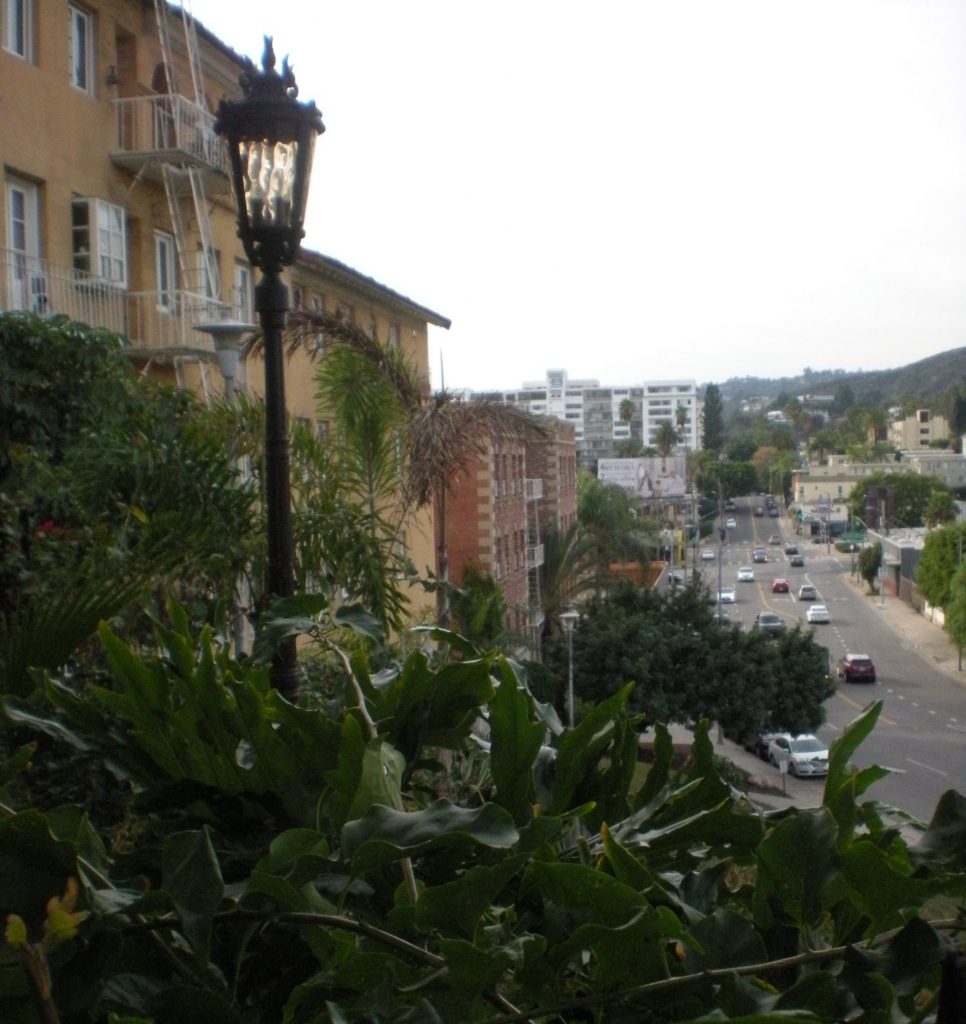HOLLYWOOD—Fuller Hill is the spot, all right, perched up on a high knoll that owns the passing Hollywood Freeway and the downhill slope of Franklin St. traffic. The sun sets, and the pedestrians cross. The perspective pulses with rhythm and even the cars seem suspended in a pleasurably drowsy trance. Up here on Fuller Hill I can go to gather my wits.
An ashtray has been thoughtfully left on a pedastal table. I can read. I can smoke. I can look at the hills and the houses that cling to the hills and whose windows reflect the tawny sunset. And I can read the graffitti spray-painted on a cement flank of a vintage 1950 freeway overpass. It is a place I can count on to gather my wits, and get above the grinding cacophony of recontructing Hollywood.
Or I could, at least until recently… Great was my chagrin–so great it could be wrapped up in a pretty box and tied with a holly-red bow–to gain the top of the hill at the top of Ivar, alongside my dog DeVille, and see no table in sight. Both tables had been removed. There was still a concrete curb which would serve as a nice place to sit and read awhile, while the whishing sound of traffic and the softly blinking lights would calm me. I amazingly kept my calm, since I was acutely aware of too many days deprived of this soothing vantage established by Sam Fuller, but of course the New York newspaper reporter turned director of films like “Shock Corridor,” hard-hitting, social works. Well, he’s dead, I thought: Sam Fuller won’t mind. I minded. Seems like wherever I go in Hollywood something I liked is under threat: mail boxes, certain houses, the sleazy charm, and the characters.
These things are under siege. I’m almost afraid to be enthusiastic about something here lest it be razed.
I had always wondered if Sam Fuller had lived in the majestic El Nido apartment house behind that magic little spot, Fuller Hill.
Before descending I stood a long while by the door. I wanted some more lowdown on what was going on with the park. No obvious button for a manager. I am just creepy enough looking, you’d be amazed at the results I get. Through the ornate grill on the front doors, I eyed the lavish lobby festooned by Hurrel glamor shots, of Garbo, Dietrich and Gable. Christmas lights. There was a hearth with simulated flames, a table with empty candy jars.
Soon enough I’m miming to a gentleman on the inside. I didn’t look too creepy, I guess. He opened the door six inches.
“Was the park vandalized?” I asked.
“You might say that,” he opened the door and bid me to come inside the luxury-filled lobby. The man recounted how students at the nearby drama college had a party and overturned the pedestal table.
“We also had a problem with the homeless people coming up here and spending the night. There were problems. So many are not receiving the care they should receive.”
“I had to take it away before they were destroyed.”
“What about the plaque?”
“I had to remove the plaque, too. Before it was damaged. I’m the one who had that made.”
Now was my chance and I asked:
“What was the role of Sam Fuller founding the park?”
The man looked at me.
“I am Sam Fuller. I created it.”
The regalia of a dead Hollywood legend was immediately dispensed with. I knew I was in the presence of the only Sam Fuller who mattered at this moment.
Grady Miller is contributing editor to the Literary Journal, 80 mph https://amzn.to/2SgWt3i






